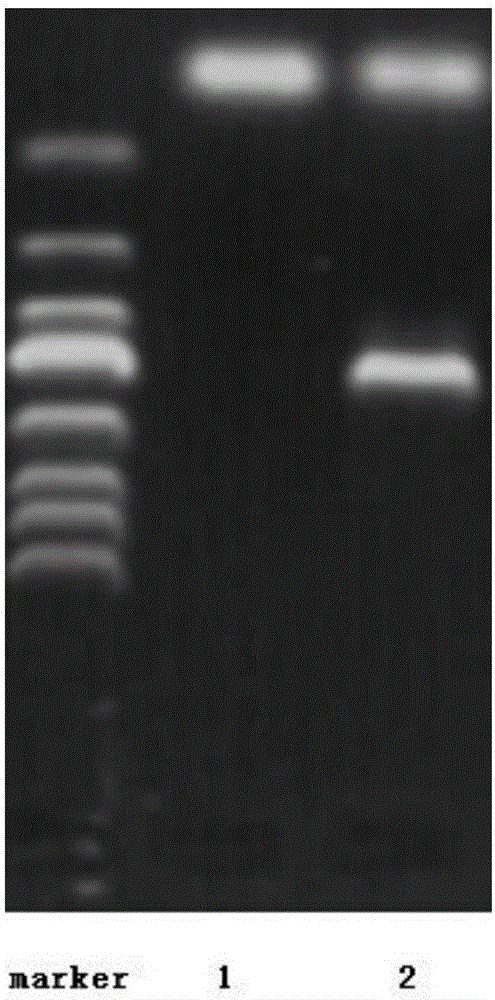Method of enabling exogenous DNA to penetrate cell barriers to enter penicillium notatum resting spores
A technology for dormant spores and Penicillium pipiens, which is applied in the field of allowing exogenous DNA to penetrate the cell barrier and enter the field of Penicillium pipiens dormant spores, so as to avoid killing cells, improve cell survival rate, and eliminate the effect of cathodic effect.
- Summary
- Abstract
- Description
- Claims
- Application Information
AI Technical Summary
Problems solved by technology
Method used
Image
Examples
Embodiment 1
[0058] A method for exogenous DNA to penetrate cell barriers and enter dormant spores of Penicillium pointis, comprising the following steps:
[0059] 1) Point Penicillium culture and spore collection
[0060] In a 15cm petri dish, prepare a solid agar medium (PDA medium), inoculate Penicillium SIIM M80 on the surface of the solid agar medium, at a temperature of 26°C and a humidity of 50-60%, and cultivate for 4 days to allow the surface of the medium to be covered with Point Penicillium spores.
[0061] Pour sterile water onto the surface of the medium, wash off (shake, or gently scrape with a smooth sterile glass applicator) the Penicillium spores on the surface of the medium, suck out the spore suspension with a pipette, and use a sterile Filter with sterilized lens tissue (or sand core funnel, filter paper, etc.) to remove mycelia and retain spores. The filtered liquid is put into a centrifuge tube. After centrifugation, collect the precipitated dormant spores and remove...
Embodiment 2
[0085] A method for exogenous DNA to penetrate cell barriers and enter dormant spores of Penicillium pointis, comprising the following steps:
[0086] 1) Point Penicillium culture and spore collection
[0087] In a 15cm petri dish, prepare a solid agar medium (YPD medium), inoculate Penicillium SIIM M80 on the surface of the solid agar medium, and cultivate it for 15 days at a temperature of 16°C and a humidity of 15-50%. Overgrown with Penicillium spores.
[0088] Pour sterile water onto the surface of the medium, wash off (shake, or gently scrape with a smooth sterile glass applicator) the Penicillium spores on the surface of the medium, suck out the spore suspension with a pipette, and use a sterile Filter with sterilized lens tissue (or sand core funnel, filter paper, etc.) to remove mycelia and retain spores. The filtered liquid is put into a centrifuge tube. After centrifugation, collect the precipitated dormant spores and remove the supernatant. The obtained spores wi...
Embodiment 3
[0102] A method for exogenous DNA to penetrate cell barriers and enter dormant spores of Penicillium pointis, comprising the following steps:
[0103] 1) Point Penicillium culture and spore collection
[0104] In a 15cm petri dish, prepare a solid agar medium (PDA medium), inoculate Penicillium SIIM M80 on the surface of the solid agar medium, and cultivate it for 3 days at a temperature of 40°C and a humidity of 60-85%. Overgrown with Penicillium spores.
[0105] Pour sterile water onto the surface of the medium, wash off (shake, or gently scrape with a smooth sterile glass applicator) the Penicillium spores on the surface of the medium, suck out the spore suspension with a pipette, and use a sterile Filter with sterilized lens tissue (or sand core funnel, filter paper, etc.) to remove mycelia and retain spores. The filtered liquid is put into a centrifuge tube. After centrifugation, collect the precipitated dormant spores and remove the supernatant. The obtained spores wil...
PUM
 Login to View More
Login to View More Abstract
Description
Claims
Application Information
 Login to View More
Login to View More - R&D
- Intellectual Property
- Life Sciences
- Materials
- Tech Scout
- Unparalleled Data Quality
- Higher Quality Content
- 60% Fewer Hallucinations
Browse by: Latest US Patents, China's latest patents, Technical Efficacy Thesaurus, Application Domain, Technology Topic, Popular Technical Reports.
© 2025 PatSnap. All rights reserved.Legal|Privacy policy|Modern Slavery Act Transparency Statement|Sitemap|About US| Contact US: help@patsnap.com

